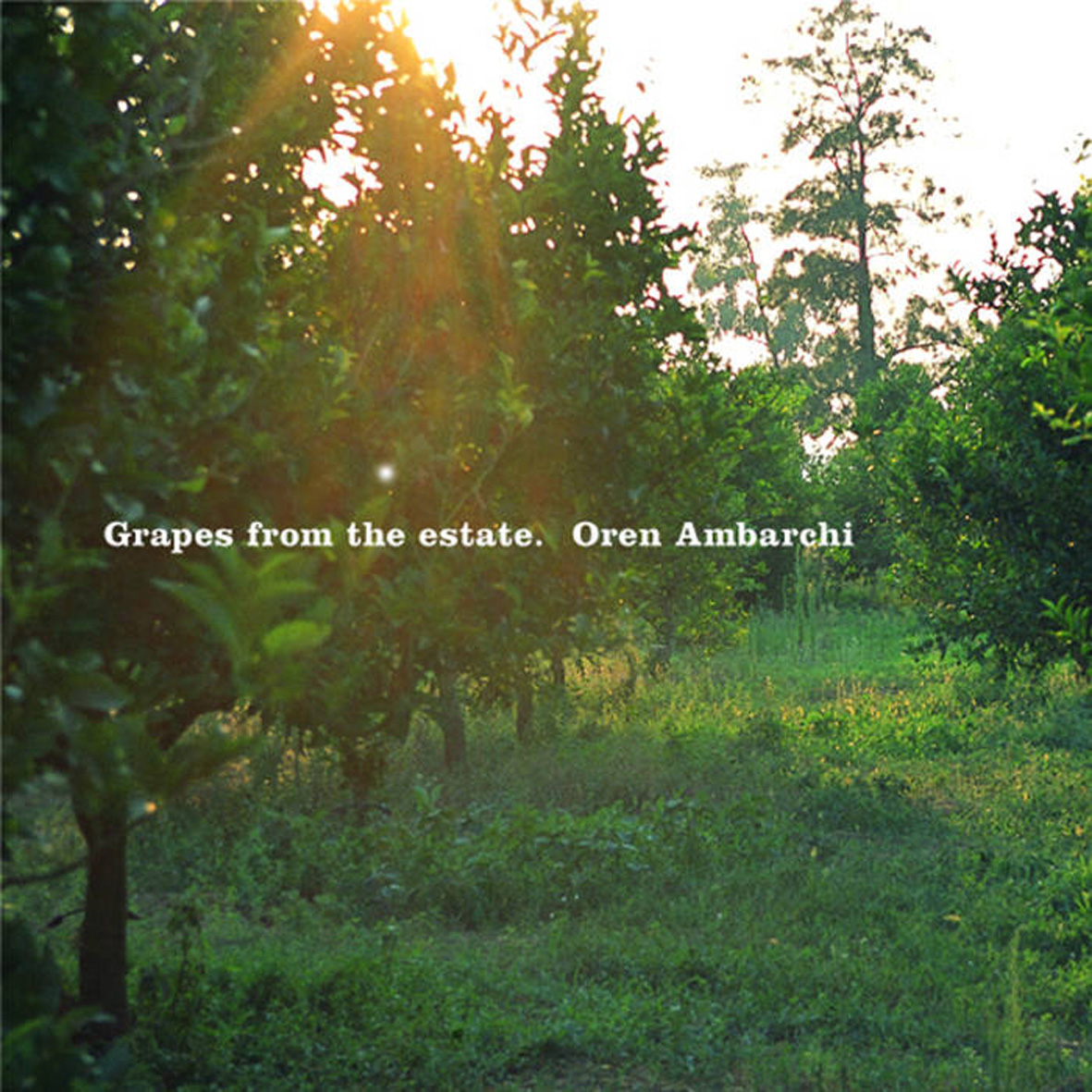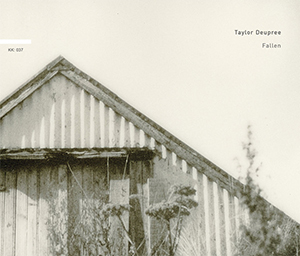
I can think of few other artists who have amassed a body of work as impressive as Clarice Jensen before releasing their debut album, as she is the artistic director of the American Contemporary Music Ensemble (ACME) and has appeared as a cellist on albums by a wide array of great artists (William Basinski, Bjork, and Jóhann Jóhannsson among them). The late Jóhannsson, in particular, is a solid reference point, as Jensen's vision shares a lot of common ground with Fordlandia's blend of neo-classical grandeur and contemporary experimentation. In fact, the man himself surfaces here as Jensen's collaborator on the opening "BC," which is one of several intriguing collaborative threads that run throughout the album. Unsurprisingly, that piece is absolutely gorgeous, yet it is Jensen's two-part solo composition that stands as the stands as the album's towering centerpiece.



 Anne Guthrie's strange and beautiful Codiaeum Variegatum was one of 2014's most delightful surprises, but I was admittedly perplexed by the early samples that I heard from this follow-up. Brass Orchids is quite a radical departure from its predecessor, as the erstwhile French horn player has now plunged deeply into a hallucinatory miasma of collaged and murky field recordings. As such, Orchids is quite a challenging and abstract album, but its dense fog of unusual textures and found sounds occasionally coheres into something quite compelling and unique. Also, Guthrie definitely gets points for so boldly swimming against the tide of the experimental music zeitgeist, reminding me favorably of the golden age of the early '80s when serious Italian composers were making bizarre noise tapes.
Anne Guthrie's strange and beautiful Codiaeum Variegatum was one of 2014's most delightful surprises, but I was admittedly perplexed by the early samples that I heard from this follow-up. Brass Orchids is quite a radical departure from its predecessor, as the erstwhile French horn player has now plunged deeply into a hallucinatory miasma of collaged and murky field recordings. As such, Orchids is quite a challenging and abstract album, but its dense fog of unusual textures and found sounds occasionally coheres into something quite compelling and unique. Also, Guthrie definitely gets points for so boldly swimming against the tide of the experimental music zeitgeist, reminding me favorably of the golden age of the early '80s when serious Italian composers were making bizarre noise tapes.
 Remarkably, this is the first Bruce Gilbert solo album that I have ever heard in its entirety and I was pleasantly surprised to discover that it is radically different from any of his other work that I have encountered: it is clear that I woefully underestimated the depth and breadth of the Gilbert oeuvre. This latest release continues to delve deeper into the coldly futuristic and menacing vein of his previous Editions Mego album (2009's Oblivio Agitatum), yet does so in wonderfully explosive and visceral fashion. Ex Nihilo feels like the soundtrack for a bleakly alienating dystopian city of endless metal and neon, composed by a cyborg with a fairly hostile disposition. Those hoping for any trace of melody or tenderness in Gilbert's industrial dread should probably skip this one, but there is definitely a gleaming, inhuman majesty to these grinding and throbbing soundscapes.
Remarkably, this is the first Bruce Gilbert solo album that I have ever heard in its entirety and I was pleasantly surprised to discover that it is radically different from any of his other work that I have encountered: it is clear that I woefully underestimated the depth and breadth of the Gilbert oeuvre. This latest release continues to delve deeper into the coldly futuristic and menacing vein of his previous Editions Mego album (2009's Oblivio Agitatum), yet does so in wonderfully explosive and visceral fashion. Ex Nihilo feels like the soundtrack for a bleakly alienating dystopian city of endless metal and neon, composed by a cyborg with a fairly hostile disposition. Those hoping for any trace of melody or tenderness in Gilbert's industrial dread should probably skip this one, but there is definitely a gleaming, inhuman majesty to these grinding and throbbing soundscapes. Seemingly birthed from the same fascination with vinyl surface noise as The Sky With Broken Arms, Roberto Opalio's solo companion piece is perhaps even more unique and consciousness-expanding than its sister. It is also unexpectedly varied and weirdly beautiful at times, blurring together the usual deep-space lysergia with viscerally unnerving dissonances and hypnotically looping crackles and pops. While those added touches certainly delight me, this album is unmistakably and absolutely Opalio-esque to its core, standing as one of the most sharply realized and distilled releases in the MCIAA oeuvre. If The Sky With Broken Arms is a brief glimpse into a hypnotically otherworldly scene, Once You'll Touch The Sky is a phantasmal travelogue of the troubled dreams that follow in its wake.
Seemingly birthed from the same fascination with vinyl surface noise as The Sky With Broken Arms, Roberto Opalio's solo companion piece is perhaps even more unique and consciousness-expanding than its sister. It is also unexpectedly varied and weirdly beautiful at times, blurring together the usual deep-space lysergia with viscerally unnerving dissonances and hypnotically looping crackles and pops. While those added touches certainly delight me, this album is unmistakably and absolutely Opalio-esque to its core, standing as one of the most sharply realized and distilled releases in the MCIAA oeuvre. If The Sky With Broken Arms is a brief glimpse into a hypnotically otherworldly scene, Once You'll Touch The Sky is a phantasmal travelogue of the troubled dreams that follow in its wake. For his first solo album on a label other than his own for quite some time (although 12k and Spekk could almost be siblings in the world of record labels), Fallen features the prolific sound artist turning his focus to beautifully understated sounds to the piano, culminating in eight songs of delicate and pensive tones, with the focus shifting between the pure sounds of the instrument to gorgeous production and back again.
For his first solo album on a label other than his own for quite some time (although 12k and Spekk could almost be siblings in the world of record labels), Fallen features the prolific sound artist turning his focus to beautifully understated sounds to the piano, culminating in eight songs of delicate and pensive tones, with the focus shifting between the pure sounds of the instrument to gorgeous production and back again. Joao Da Silva’s latest release under his Luciernaga guise was a quickly made work, but that is anything but apparent from the contents. The tape, recorded this past winter, is an excellent summation of the work Da Silva has been involved with for the past eight years, with some additional and unexpected twists and turns along the way. Rich electronics, unconventional guitar, and lush production all define this latest entry in the growing Luciernaga discography.
Joao Da Silva’s latest release under his Luciernaga guise was a quickly made work, but that is anything but apparent from the contents. The tape, recorded this past winter, is an excellent summation of the work Da Silva has been involved with for the past eight years, with some additional and unexpected twists and turns along the way. Rich electronics, unconventional guitar, and lush production all define this latest entry in the growing Luciernaga discography. It has been roughly four years since Ashley Paul's last album and I was beginning to despair, but she has been busy moving to London and becoming a mother. While the latter is not particularly conducive to tirelessly crafting brilliant experimental music, she somehow still managed to compose her finest album to date during a brief residency in Spain. Characteristically, the pointillist, prickly dissonance of Jandek is probably the nearest touchstone, yet Paul radically transforms that stark foundation into something sensuous and eerily beautiful (sometimes even embellishing it with perversely festive splashes of color).  In fact, a few pieces even sound like grotesque caricatures of nursery rhymes (Paul’s baby was perhaps a subconscious and subversive muse), which only deepens Lost in Shadows' dreamily wraithlike and otherworldly spell. While it can definitely be a challenging, dissonant, and disturbing listen at times, Shadows is unquestionably Paul's masterpiece.
It has been roughly four years since Ashley Paul's last album and I was beginning to despair, but she has been busy moving to London and becoming a mother. While the latter is not particularly conducive to tirelessly crafting brilliant experimental music, she somehow still managed to compose her finest album to date during a brief residency in Spain. Characteristically, the pointillist, prickly dissonance of Jandek is probably the nearest touchstone, yet Paul radically transforms that stark foundation into something sensuous and eerily beautiful (sometimes even embellishing it with perversely festive splashes of color).  In fact, a few pieces even sound like grotesque caricatures of nursery rhymes (Paul’s baby was perhaps a subconscious and subversive muse), which only deepens Lost in Shadows' dreamily wraithlike and otherworldly spell. While it can definitely be a challenging, dissonant, and disturbing listen at times, Shadows is unquestionably Paul's masterpiece. I have been casually aware of Slomo since the murky, gnarled gloom of 2008's The Bog, but apparently not familiar enough to realize that each of their infrequent releases tends to unveil a significant evolution. As a result, I slept on this 2017 release, only belatedly realizing that it was one of the year's most woefully overlooked masterpieces. With Transits, Chris McGrail and Howard Marsden shed all traces of their doom-shrouded ambient sludge past to craft a transcendently lysergic tour de force of pulsing minimalist drone brilliance. I am always hesitant to throw around Coil as a comparison for any artist, yet I am legitimately hard-pressed to think of any closer kindred album than Time Machines, as Slomo achieve a similarly singular feat of reality-blurring slow-motion wizardry that feels far more like a ritual or invocation than a mere album.
I have been casually aware of Slomo since the murky, gnarled gloom of 2008's The Bog, but apparently not familiar enough to realize that each of their infrequent releases tends to unveil a significant evolution. As a result, I slept on this 2017 release, only belatedly realizing that it was one of the year's most woefully overlooked masterpieces. With Transits, Chris McGrail and Howard Marsden shed all traces of their doom-shrouded ambient sludge past to craft a transcendently lysergic tour de force of pulsing minimalist drone brilliance. I am always hesitant to throw around Coil as a comparison for any artist, yet I am legitimately hard-pressed to think of any closer kindred album than Time Machines, as Slomo achieve a similarly singular feat of reality-blurring slow-motion wizardry that feels far more like a ritual or invocation than a mere album. It was quite a pleasant surprise to discover that latest Hawthonn album was getting a physical release in the US, as few things scream "zero commercial potential" quite like Phil and Layla Legard’s quasi-pagan and psychogeography-inspired drone-folk reveries. While characteristically arcane and anachronistic to its core, Red Goddess actually drew its initial inspiration from relatively current culture, as the Legards were (rightly) fascinated by the primal themes of Lars von Trier's Antichrist. From there, however, Red Goddess evolved into something far more mysterious and temporally ambiguous, abstractly exploring the symbolic role of mugwort in folklore and tradition ("an herb associated with dreaming, travel and menstruation, mugwort particularly favors edgelands: those abandoned, untended places, part man-made, part rural, where nature begins to reclaim what humanity has left behind").
It was quite a pleasant surprise to discover that latest Hawthonn album was getting a physical release in the US, as few things scream "zero commercial potential" quite like Phil and Layla Legard’s quasi-pagan and psychogeography-inspired drone-folk reveries. While characteristically arcane and anachronistic to its core, Red Goddess actually drew its initial inspiration from relatively current culture, as the Legards were (rightly) fascinated by the primal themes of Lars von Trier's Antichrist. From there, however, Red Goddess evolved into something far more mysterious and temporally ambiguous, abstractly exploring the symbolic role of mugwort in folklore and tradition ("an herb associated with dreaming, travel and menstruation, mugwort particularly favors edgelands: those abandoned, untended places, part man-made, part rural, where nature begins to reclaim what humanity has left behind").
